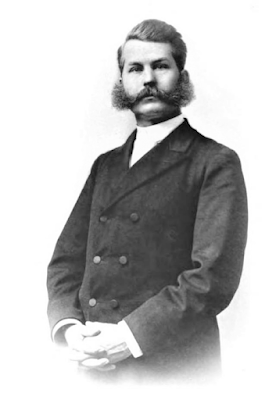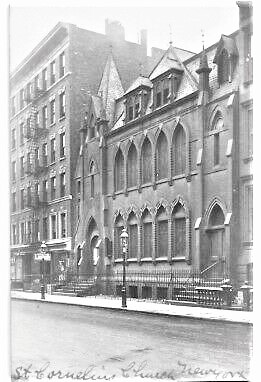Founded in 1829, the West Presbyterian Church was located in Greenwich Village. In 1866 the congregation established a reformed church mission in the crime-ridden, dangerous district known as Hell's Kitchen. Four years later, in November 1870, Edward Delano Lindsey filed plans for a "three-story brick chapel" on West 46th Street, between Ninth and Tenth Avenues. (The fledgling architect, a graduate of Harvard, had been in practice only three years.)
His delightful Ruskinian Gothic style structure could have inspired cartoonist Edward Gorey a century later. The asymmetrical design with its surplus of pointed-arched openings forewent expensive stone trim, yet Lindsey's use of creative brickwork, fishscale slate tiles, and ample stained glass more than made up for it.
His delightful Ruskinian Gothic style structure could have inspired cartoonist Edward Gorey a century later. The asymmetrical design with its surplus of pointed-arched openings forewent expensive stone trim, yet Lindsey's use of creative brickwork, fishscale slate tiles, and ample stained glass more than made up for it.
The 26-year old Rev. James Hart Hoadley, was appointed Faith Chapel's first permanent pastor in 1873. Having grown up in the quiet village of Collinsville, New York, the impoverished, gang-ridden Hell's Kitchen neighborhood must certainly have been both challenging and intimidating to him.
But, however daunting his work, he prevailed. On January 21, 1877 the New York Herald wrote:
Faith Chapel, a mission of the West Presbyterian church of this city, under the pastorate of Rev. J. H. Hoadley, has been very successful during the year 1876. Its membership has been increased by 139, and now numbers 350 souls, and its Sunday school numbers nearly 1,000 scholars, 67 of whom were added during the year. The religious interest is increasing.
Hoadley's success was such that on November 12, 1883, ten years after he took the pulpit, the Presbytery of New York "decided to organize Faith Chapel, at No. 423 West Forty-sixth-st., into a Presbyterian Church," as reported by the New-York Tribune the next day. It was now known as Faith Presbyterian Church. The New York Times reported, "The West Presbyterian Church, to which the chapel belongs, will rent it to the congregation for $10 a year, and if it prospers will make it a gift to the new congregation."
At the time, the membership had grown to 560, severely taxing the viability of the building designed for around half that amount. On May 10, 1897 the New-York Tribune reported, "The congregation Faith Presbyterian Church, which formerly was situated in Forty-sixth-st., west of Ninth-ave., opened their new house of worship in Forty-eighth-st., east of Ninth-ave., yesterday."
The 46th Street church did not sit vacant for long. On June 7, 1897 The New York Times reported:
The congregation of the Protestant Episcopal Church of St. Cornelius, which has grown out of the chapel connected with the Church of Zion and St. Timothy, and been recently incorporated as an independent parish, held the opening services yesterday in their new edifice, 423 West Forty-sixth Street.
The article noted that, "There is also a well-fitted basement which may be used for Sunday school and lecturing purposes." Weekly lectures became a staple at the Church of St. Cornelius, very often addressing issues of interest to the hard-working neighborhood residents. On February 27, 1898, for instance, Robert L. Harrison spoke on "The Condition of the Workingman One Hundred Years Ago and Today."
According to Episcopal canon, the church could not be consecrated until it was free of debt. Its pastor, Rev. Dr. Isaac C. Sturges, worked tirelessly and raised $45,000 within seven years. Then, in December 1904, an anonymous donor gave a "Christmas gift in memory of a friend of the church." The windfall--equal to $420,000 today--freed the congregation from all debt. St. Cornelius's Episcopal Church was formally consecrated on February 19, 1905.
The relevant weekly lectures continued. In April 1907 Orlande F. Lewis of the Charity Organization Society spoke on "The Homeless Man," and on November 24, 1908 Dr. Edward G. Coburn described, "What Vaccination Has Accomplished," for instance.
But one speech especially caught the attention of the press. The Hell's Kitchen neighborhood was greatly populated by Irish Catholic immigrants. And so when Irishman John N. Dancey addressed a group in the Sunday School rooms on May 20, 1914, reporters took note. Dancy was known as an Orangeman--a group of Northern Irish Protestants fervently aligned with the British monarchy.
The Sun considered, "Perhaps young John N. Dancey of the Ulster Unionist Alliance...didn't realize, being new to the city, that he and the close packed audience of Orangemen whom he addressed last night had assembled so close to Tenth Avenue." The article noted, "because of the heat, the windows of the Sunday school room of the Protestant Episcopal Church of St. Cornelius...were wide open, and Mr. Dancey speaks with powerful emphasis."
His bellowing voice carried out into the streets saying, in part, "in spite of the efforts of the Irish American societies in the United States and all these people paid to tell you differently, there will never be home rule in Ireland." But despite the apprehensions of some, no trouble came. The Sun reported, "no one in the district seemed to know that Mr. Dancey was to speak so close to their firesides."
On June 19, 1920 the Real Estate Record & Builders' Guide reported that the Church of St. Cornelius had sold its building to the trustees of St. Clement's Church. That congregation, founded in 1830 in Greenwich Village, had just merged with the Chapel of St. Chrysostom, a mission chapel of Trinity Church.
On January 9, 1929 the parish hall was the scene of "a pageant of the Epiphany, depicting the coming of the Three Wise men, bearing gifts to the Christ Child," according to The New York Sun. The article added, "Following the pageant will be acted the play 'Why the Chimes Rang,' by Raymond Macdonald Alden. The cast will include members of St. Clement's parish and of the Episcopal Actors' Guild." It was a foreshadowing of things to come.
The Rev. Thomas A. Sparks had been rector of St. Clement's Church since it moved into the West 46th Street building. In his farewell sermon on September 14, 1930, he stressed, "The Church should not appeal to class, color or race, but should minister to all God's children." This, too, predicted the course that the congregation and its pastors would follow.
On April 8, 1963, The New York Times began an article saying, "An Off Broadway venture that has the blessing of the Protestant Episcopal Bishop of New York is burgeoning in the West Forties." Rev. Sidney Lanier, vicar of St. Clement's, had led an unusual Palm Sunday service the previous afternoon. British actor, Patrick Waddington read the lesson and Don Morland, understory for a lead in Strange Interlude read part of the sermon--one of three letters that took the place of a normal sermon.
The article noted, "Mr. Lanier and his staff are working to create 'The American Place Theater.' Mr. Lanier calls it 'a place that inspires, fosters and produces written works for a theater that concerns itself with the crucial themes of contemporary life." Already Lee Strasberg's Actors' Studio was using the basement workshop for rehearsals. The New York Times said, "Recently a scene from 'Look Back in Anger' was presented before the regular church service began."
Among those involved in the American Place Theater project was playwright Molly Kazan, wife of stage and screen director Elia Kazan. She was working on a program, An Evening of Camus, when, on December 14, 1963, she died of a cerebral hemorrhage two days before her 57th birthday. Her funeral was held in St. Clement's Church on December 19, with Elia Kazan delivering her eulogy. The New York Times noted that among the 400 mourners present were Tennessee Williams, Arthur Miller, Paddy Chayefsky, Abe Burrows, Joshua Logan, Lee Strasberg, Jo Van Fleet, William Inge, Warren Beatty and other luminaries of American theater.
Two months later, on February 12, 1964, The New York Times reported that $100,000 was being raised to renovate "the church's large upstairs hall for both worshipers and theatergoers." The first production scheduled following construction, said the article, would be the three-part The Old Glory, by Pulitzer Prize-winning poet Robert Lowell. Starring Frank Langella, Roscoe Lee Browne, and Lester Rawlins, the play won five Obie Awards in 1965, including Best American Play, as well as awards for the three stars.
The line between theater and worship at St. Clement's was often blurry. On May 30, 1965, for instance, the communion service began with a short, one-act play, A Study in Color. The New York Times explained, "Race relations and the inability of white America to understand nonwhite America was the theme."
But, disturbingly, in many respects the socio-economic demographics of Hell's Kitchen had changed little over the decades. In the summer of 1969 the church was the target of vicious vandalism, including a firebomb tossed through a window on August 22. The vicar, Rev. Eugene A. Monick, Jr., explained, "We have a sophisticated congregation, an experimental congregation, and we do a lot of innovating. The old grass-roots families--who are so peculiar to the Hell's Kitchen area--don't like us."
Indeed, some did not. Vandals had painted the doors and façade of the church with, "All niggers should be killed," "46th Street against niggers," and "White power-Nazi power." Rev. Monick was visibly frustrated. "I don't know how we can come to terms with the community," he told a reporter from The New York Times on August 26.
Among the last plays to be staged by the American Place Theater within St. Clement's Church was Sam Shepard's Back Bog Beast Bait, on April 29, 1971. The New York Times announced, "Also on the program will be a short play, 'The Cowboy Mouth,' by Mr. Shepard and Patti Smith." Later that year the American Place Theater moved to its own venue.
But drama continued at St. Clements with its weekly "Mass in the Theatre," the Cornerstone Theater Company and, later, the Saint Clements Theatre. Today the congregation describes itself as one "that has always celebrated the ministry of women, of gay and lesbian people, and those of all walks of life; a longtime center of service to the poor, celebrating social activism and creative liturgy," and "one of the most diverse Episcopal parishes in New York City."
photographs by the author
LaptrinhX.com has no authorization to reuse the content of this blog




.png)

No comments:
Post a Comment